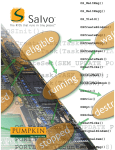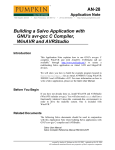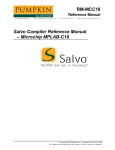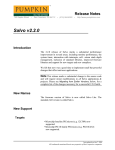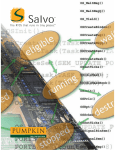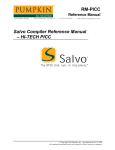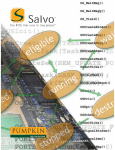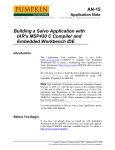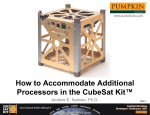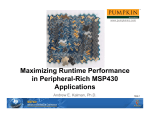Download Using the RTOS on TI`s MSP430
Transcript
Using the
RTOS on TI's MSP430
speaker: Andrew E. Kalman, Ph.D.
nd
Presented at TI's 2
Annual MSP430 Advanced Technical Conference, Ft. Worth, Texas, Nov. 11-13, 2003
www.pumpkininc.com
PART I
Introduction to Salvo
The Salvo™ RTOS on TI's MSP430
–1–
www.pumpkininc.com
The Source – Pumpkin, Inc.
● An embedded solutions company
● Established 1995 in San Francisco, California
● Focused on providing highest-quality tools for embedded
system designers
● Active in both hardware and software design for a variety of
end-user clients
● Works closely with chip and compiler vendors to assure
maximum value for Salvo users
The Salvo™ RTOS on TI's MSP430
–2–
www.pumpkininc.com
Salvo – A Unique RTOS
● Minimal on-chip resource requirements
● Designed expressly for use in single-chip µC's
● Event-driven, priority-based, cooperative multitasking
● Certified for use with all major MSP430 compilers:
● Available in different flavors:
● Salvo Lite
freeware / demo / evaluation
● Salvo tiny
included with some compilers / IDEs
● Salvo SE
available from certain compiler vendors
● Salvo LE
all supported functionality
● Salvo Pro
Salvo LE + source code
● Portable (cross-compiler and cross-target)
● Highly configurable (written 98% in C)
● Easy to learn
● Royalty-free
The Salvo™ RTOS on TI's MSP430
–3–
www.pumpkininc.com
Who Uses It, and How
● World-wide user base
● Large Corporations
● U.S. Military
● Smaller Companies
● Educational Institutions
● Individual Consultants
● Governmental Organizations
● Applications include:
● Military
● Space
● Avionics
● Telecom
● Recreation
● Wireless
● Data logging
● Robotics
● Safety devices
● Food handling
● GPS equipment
● Transportation
● Medical devices
● Instrumentation
● Handheld devices
● Alternative energy
● Industrial / process control
● Autonomous vehicles
The Salvo™ RTOS on TI's MSP430
–4–
www.pumpkininc.com
What's Included
● Comprehensive user manual (over 500 pages)
● Every distribution contains:
● Configurable installer
● Salvo libraries
● Tutorial and example projects
● "Getting started" application notes
● Compiler reference manuals
● Additional resources for Salvo users:
● Responsive tech support
● Web forums
The Salvo™ RTOS on TI's MSP430
–5–
www.pumpkininc.com
Compared to other Programming Methodologies
Interrupt latency
Interrupt response
Task response
Stack requirements
RAM requirements
ROM requirements
Intrusiveness
Coupling
Extensibility
Handles complexity
Effort to learn
Foreground /
Background
Preemptive
RTOS
Cooperative
RTOS
Salvo
RTOS
low
low
low
low
varies
user
user
tight
poor
poorly
least
moderate
high
fast
high
high
high
high
loose
excellent
well
most
low
low
moderate
moderate
moderate
moderate
moderate
loose
excellent
well
more
low
low
moderate
low
low
moderate
low
loose
excellent
well
more
The Salvo™ RTOS on TI's MSP430
–6–
www.pumpkininc.com
The RTOS Approach to System Software
Features:
● Loosely-coupled: Each task can run independently of others
● Priority-based: The highest-priority, eligible task is always running, or will
run as soon as the current task yields (i.e. context-switches)
● Event-driven: While a task is waiting, delayed or stopped, no processing
(i.e. 0 CPU cycles) is expended in "maintaining" the task
● Inter-task Communications: Distributed program execution based on
task-to-task or ISR-to-task actions
Benefits:
● Loose Coupling: Adding and / or removing tasks from the application –
even during runtime – is very simple. Application features can be easily
compartmentalized, enabled, tested, etc. Especially beneficial where
multiple programmers are involved in creating a single, large application.
● Priority-based Task Execution: Important, time-critical tasks get CPU
resources when they need them. Less-important, "do-whenever" tasks
get the CPU only when appropriate.
● Event-driven Behavior: System exhibits excellent overall system
responsiveness, because there is no polling. CPU resources are always
directed towards the highest-priority eligible task. System is always
"primed, waiting for an event" and can sleep between events.
● Inter-task Communications: Connect loosely-coupled processes in a
well-defined manner.
The Salvo™ RTOS on TI's MSP430
–7–
www.pumpkininc.com
Features and Operational Details
Tasks:
● 16 dynamic task priority levels
● "Run forever" task structure
● Tasks can be created, started, stopped, destroyed, etc.
● A context switch always results in the most-eligible task running
● Constraints:
● Context switch may only occur at the task level
● A tasks' local / auto variables are usually replaced with static
variablesi
Events:
● Binary semaphores, semaphores, messages, message queues and
event flags are supported
● Events can be created and signaled from anywhere. Tasks can wait
events (with optional timeouts)
Timers:
● Single system timer controls all task delays and timeouts, as well as
system tick services
● OSTimer() can be called from any periodic timer
The Salvo™ RTOS on TI's MSP430
–8–
www.pumpkininc.com
MSP430 Port
Memory Requirements
● RAM usage per task control block: 14 bytes max.ii
● RAM usage per event control block: 6 bytes max.iii
● Stack size: Similar to typical foreground / background application
● ROM usage: 400-1700 bytes
tutorial memory usageiv
total ROMv
total RAMvi
450
596
638
1148
1562
vii
1678
ix
1550
22
22
24
34
50
viii
52
x
48
tu1lite
tu2lite
tu3lite
tu4lite
tu5lite
tu6lite
tu6pro
Table 1: ROM and RAM requirements for Salvo Applications
built with IAR's MSP430 C Compiler
Context Switching
25µs @ MCLK = 8MHz (with priorities, events, etc.)xi
Interrupt Control
● Default configuration is for GIE to be disabled during critical sections
● Interrupt latency can be minimized via user (re-)configuration of interrupt
controlxii
The Salvo™ RTOS on TI's MSP430
–9–
www.pumpkininc.com
MSP430 Real-world Results
Suitability
● MSP430's 2K RAM and 60K ROM are ideal for Salvo applications – 20task, 30-event application consumes under 15% RAM and 5% ROM,
leaving plenty of RAM and ROM for user application
● Salvo runs on every member of the MSP430 family
Low Power
● Salvo's event-driven multitasking allows application to sleep at all times,
waking only for activity (i.e. internal or external events)
Performance
● MSP430's highly orthogonal instruction set and comprehensive
addressing modes mean rapid execution of Salvo services
Tools
● Non-intrusive, easy to debug
● Works seamlessly with all major toolsets
● Pumpkin and MSP430 compiler vendors are actively involved in further
integrating Salvo into their toolsets
The Salvo™ RTOS on TI's MSP430
– 10 –
www.pumpkininc.com
Conclusion
● Using Salvo on the MSP430 helps the embedded designer in:
● Implementing new designs quickly
● Enhancing functionality using existing on-chip resources
● Improving real-time performance
● Multitasking
● Using memory efficiently
● Minimizing costs
● Managing complexity
● Reducing time-to-market
"… let me say that the RTOS has exceeded all of
our expectations and we are grateful for your excellent
support."
Mark Mayernick
Salvo + MSP430 user
Datex-Ohmeda
The Salvo™ RTOS on TI's MSP430
– 11 –
www.pumpkininc.com
PART II
Example Salvo
Application
The Salvo™ RTOS on TI's MSP430
– 12 –
www.pumpkininc.com
MSP430F149-based Design Example
● Hardware Details:
● P6 shared between:
● USB / transceiver handshake / control interface
● Transceiver isolation
● Analog sampling channels (e.g temp sensors)
● USART1 shared between:
● Serial-to-USB converter
● 2.4GHz spread-spectrum wireless transceiver
● User (off-board)
● Mixed +3.3V / +5V design:
● Level translators & buffers provide isolation, incl. unpowered states
● USB (+5V, bus-poweredxiii) interfaces to MCU at +3.3V via isolator
● Transceiver (+5V) interfaces to MCU via isolators & level-shifters
● MCU controls –OE's on isolators & level-shifters
● MCU controls power to +5V transceiver
● Low-Power:
● Sleep at < 30µA,xiv operate at < 2mA, Tx (occasionally) at > 750mA
● Powered via internal +5V or via USB
The Salvo™ RTOS on TI's MSP430
– 13 –
www.pumpkininc.com
● Block Diagram:
+5V_USB
VCC
+5V
OFF
LDO
JTAG
MSP430
Transceiver
UART1
h/s
UART0
VREF
+5V_USB
2
2
USB<->Serial
3
Reset
2
2
RS-232
2
+5V_USB +5V
+5V_SW
VCC
P1
P2
The Salvo™ RTOS on TI's MSP430
– 14 –
P3
P4
P5
P6
www.pumpkininc.com
● Software Requirements:
● USART1:
● Manage isolation & interface to USB / transceiver / user to avoid
contention
● USB:
● Detect when USB I/F is present
● Acquire & release USB interface
● Transceiver:
● Tx / Rx when requested
● Acquire & release transceiver interface, including the control of
transceiver power when Tx'ing / Rx'ing
● P6:
● Sample at a variety of rates via A/D inputs
● Handshake control to USB / transceiver interface
● Other Processes:
● Perform a myriad of other simultaneous operations (e.g. data
processing, system status reporting, storing and retrieving data to /
from external NVRAM, etc.)
● Power Consumption:
● Sleep whenever no activity is warranted
The Salvo™ RTOS on TI's MSP430
– 15 –
www.pumpkininc.com
Task to Read Ambient Temperature
Configure ADC12 and read internal temperature sensor at 1/2Hz
unsigned int ADCresult;
unsigned long int DegC;
…
void TaskMeasureAmbientTemp( void )
{
/* setup ADC12 to read ch 10, etc. */
ADC12CTL0 = ADC12ON+REFON+REF2_5V+SHT0_6;
ADC12CTL1 = SHP;
ADC12MCTL0 = INCH_10+SREF_1;
/* wait 10ms for reference startup */
OS_Delay(1, label);
/* enable conversions */
ADC12CTL0 |= ENC;
for (;;)
{
ADC12CTL0 |= ADC12SC;
// start conversion
OS_Delay(200, label);
// wait 2s
ADCresult = ADC12MEM0; // read result
DegC = ((((long)ADCresult-1615)*704)/4095); // calc. DegC
}
}
The Salvo™ RTOS on TI's MSP430
– 16 –
www.pumpkininc.com
TaskMeasureAmbientTemp()
● Attributes:
● Runs independently of others, i.e. loosely-coupled.
● Runs at a low priority. Ambient temp sensing is not a high-priority issue in
this system. OK if other, higher-priority tasks prevent it from running
immediately after its 2s delay expires.
● Uses minimal run-time resources. During the 2s period between
successive reads of ADC12MEM0, no CPU cycles are expended on
TaskMeasureAmbientTemp(), and other tasks are free to run.
● No inter-task communications, because it runs alone, accessing global
variables.
● Additional Features:
● Salvo's ability to context-switch at any place in the task allows other tasks
to run while TaskMeasureAmbientTemp() is waiting for 10ms delay
during ADC12 initialization.
The Salvo™ RTOS on TI's MSP430
– 17 –
www.pumpkininc.com
Task to Detect if USB is Connected
Check for USB every 250ms, signal system if present
void TaskDetectUSB( void )
{
for (;;)
{
/* proceed if USB/MHX I/F is not in use */
OS_WaitBinSem(BINSEM_USB_MHX_AVAIL_P, OSNO_TIMEOUT, label);
OpenUSBMHXIF(USB);
if ( !FM430status.USBpresent && (P1IN & BIT7) )
{
FM430status.USBpresent = 1;
FM430Msg0("DetectUSB: USB connected.");
}
else if ( FM430status.USBpresent && !(P1IN & BIT7) )
{
FM430status.USBpresent = 0;
FM430Msg0("DetectUSB: USB disconnected.");
}
/* release USB/MHX I/F */
CloseUSBMHXIF(USB);
OSSignalBinSem(BINSEM_USB_MHX_AVAIL_P);
/* come back in 25 ticks */
OS_Delay(25, label);
}
}
The Salvo™ RTOS on TI's MSP430
– 18 –
www.pumpkininc.com
TaskDetectUSB()
● Attributes:
● Runs independently of others, i.e. loosely-coupled.
● Runs at a moderate priority. System should detect USB connections
quickly.
● Uses minimal run-time resources. During the 250ms period between
testing for USB presence, no CPU cycles are expended on
TaskDetectUSB(), and other tasks are free to run.
● A binary semaphore is used to control access to a shared resource, the
USB / transceiver interface.
● Additional Features:
● TaskDetectUSB() will be "held off" until the USB / transceiver interface
is available. If the interface is not available (i.e. another task is using it),
TaskDetectUSB() will acquire it when the interface is released and
TaskDetectUSB() is the highest-priority task waiting to use the
interface.
The Salvo™ RTOS on TI's MSP430
– 19 –
www.pumpkininc.com
Task to Enable Transceiver Power During Transmission
When Interface is Available, Turn on Transceiver for 5s
void TaskTalkMHX( void )
{
for (;;)
{
/* proceed if USB/MHX I/F is not in use */
OS_WaitBinSem(BINSEM_USB_MHX_AVAIL_P, OSNO_TIMEOUT, label);
OpenUSBMHXIF(MHX);
/* turn on power to transceiver */
Enable_5V_to_MHX();
/* leave it on for 5s (length of transmission) */
OS_Delay(500, label);
/* release USB/MHX I/F */
CloseUSBMHXIF(MHX);
OSSignalBinSem(BINSEM_USB_MHX_AVAIL_P);
}
}
The Salvo™ RTOS on TI's MSP430
– 20 –
www.pumpkininc.com
TaskTalkMHX ()
● Attributes:
● Runs independently of others, i.e. loosely-coupled.
● Runs at a moderate priority.
● Uses minimal run-time resources. During the 5s period that transceiver
power is on, no CPU cycles are expended on TaskTalkMHX(), and
other tasks are free to run.
● A binary semaphore is used to control access to a shared resource, the
USB / transceiver interface.
● Additional Features:
● Like TaskDetectUSB(), TaskTalkMHX() must acquire the USB /
transceiver interface before proceeding, etc.
● During the 5s period when TaskTalkMHX() has acquired the USB /
transceiver interface, all other tasks wishing to use the interface must
wait.
● TaskTalkMHX() is incomplete. It would likely be expanded to wait on an
event that signifies that data is ready to be transmitted. After transceiver
power is enabled and the transceiver has completed its power-on
sequence, TaskTalkMHX() could signal another task to begin
transmitting data (packet-wise) over the USB / transceiver interface.
When finished, TaskTalkMHX() would receive a signal to power-down
the transceiver and release the USB / transceiver interface, and resume
waiting for a transmit-data event.
The Salvo™ RTOS on TI's MSP430
– 21 –
www.pumpkininc.com
Entering and Exiting Low-Power Modes
Sleep whenever there are no eligible tasks
void OSIdlingHook (void)
{
__low_power_mode_1();
}
OSIdlingHook() is called only when no tasks are eligible to run.
Therefore it's the ideal place to sleep the processor, until an event (i.e
an internal or external interrupt) occurs.
Exit LPM after each interrupt that calls a Salvo service
#pragma vector=TIMERA0_VECTOR
__interrupt void Timer_A (void)
{
CCR0 += 10000;
OSTimer();
__low_power_mode_off_on_exit();
}
Don't re-enter LPM until Salvo's scheduler has processed event(s). ISRs
that are independent of Salvo can resume LPM on exit.
The Salvo™ RTOS on TI's MSP430
– 22 –
www.pumpkininc.com
Putting it All Together
Initialize, create tasks and events, begin multitasking
void main (void)
{
/* user init */
Init();
/* Salvo init */
OSInit();
/* several interrupts are used */
__enable_interrupt();
/* create tasks */
OSCreateTask(TaskStatusMonitor,
OSTCBP(1), 3);
OSCreateTask(TaskDetectUSB,
OSTCBP(2), 8);
OSCreateTask(TaskTalkUSB,
OSTCBP(3), 5);
OSCreateTask(TaskTalkMHX,
OSTCBP(4), 7);
OSCreateTask(TaskMeasureAmbientTemp, OSTCBP(5), 11);
…
/* create events */
OSCreateBinSem(BINSEM_USB_MHX_AVAIL_P, 1);
/* go */
for (;;)
{
OSSched();
}
}
The Salvo™ RTOS on TI's MSP430
– 23 –
www.pumpkininc.com
Completing the Application
● Use additional binary semaphores and task priorities to manage
access to resources:
● Analog sampling tasks wait for P6 (shared with USB / transceiver
interface) to be available before proceeding
● User USART1 task waits for USART1 (used by TaskTalkUSB() and
TaskTalkMHX() to be available before proceeding
● Run additional periodic tasks at multiples of system tick period
● Use messages and message queues for intertask
communications:
● Multiple, asynchronous sampling tasks pass data to a single task that
logs captured data to NVRAM
● Highest-priority tasks wait on critical events
● Use free-running system timer for timestamps
● Handle lost events via wait-with-timeout
The Salvo™ RTOS on TI's MSP430
– 24 –
www.pumpkininc.com
Example Application Results
● Application Configured For / Uses:
● 10ms system tick period
● Multiple interrupt sources
● LPM1
● MCLK, SMCLK
● sprintf(), 16-bit multiply & divide
● Subsystems:
● Timer_A, USART0, USART1, ADC12, WDT, Digital I/O
● Salvo Configured For:
● 16-bit delays
● Priority-based multitasking
● Binary semaphores
● 15 tasks
● 32-bit system timer
● 1 event
● Salvo's Memory Requirementsxv on MSP430F149 for this
Application:
● 1132 bytes ROM (1.8%) for Salvo services
● 171 bytes RAM (8.3%) for Salvo's global objects
● Default of 90 bytes RAM (4.4%) for stack is more than sufficient
● Application's Power Consumption:
● Over 97% of the time in LPM
The Salvo™ RTOS on TI's MSP430
– 25 –
www.pumpkininc.com
Example Application Runtime Behavior
USART0 sending debug information via RS-232:
…
FM430-Tx0
FM430-Tx0
FM430-Tx0
FM430-Tx0
FM430-Tx0
FM430-Tx0
FM430-Tx0
FM430-Tx0
FM430-Tx0
FM430-Tx0
FM430-Tx0
FM430-Tx0
…
0000005451
0000005458
0000005459
0000005535
0000005860
0000005923
0000005930
0000005931
0000005982
0000005983
0000006482
0000006483
$
$
$
$
$
$
$
$
$
$
$
$
TalkUSB: Acquired USB/MHX I/F for USB.
TalkUSB: Sending to USB.
TalkUSB: Released USB/MHX I/F.
DetectUSB: USB disconnected.
DetectUSB: USB connected.
TalkUSB: Acquired USB/MHX I/F for USB.
TalkUSB: Sending to USB.
TalkUSB: Released USB/MHX I/F.
TalkMHX: Acquired USB/MHX I/F for MHX.
TalkMHX: +5V_SW is ON.
TalkMHX: +5V_SW is OFF.
TalkMHX: Released USB/MHX I/F.
USART1 sending ambient temp information via USB:
…
FM430-Tx1 0000004587
FM430-Tx1 0000004687
FM430-Tx1 0000004787
FM430-Tx1 0000004887
FM430-Tx1 0000005452
[USB disconnected]
…
[USB re-connected]
FM430-Tx1 0000005924
…
$
$
$
$
$
Ambient
Ambient
Ambient
Ambient
Ambient
temp:
temp:
temp:
temp:
temp:
19
19
19
20
20
C
C
C
C
C
$ Ambient temp: 20 C
The Salvo™ RTOS on TI's MSP430
– 26 –
www.pumpkininc.com
Thank you for your
interest in
The Salvo™ RTOS on TI's MSP430
– 27 –
www.pumpkininc.com
750 Naples Street
San Francisco, CA 94112
USA
tel: (415) 584-6360
fax: (415) 585-7948
web: http://www.pumpkininc.com/
email: [email protected]
The Salvo™ RTOS on TI's MSP430
– 28 –
www.pumpkininc.com
Speaker Information
Dr. Kalman is Pumpkin's president and chief software architect. He entered the
embedded programming world in the mid-1980's. After co-founding a successful
Silicon Valley high-tech startup, he founded Pumpkin with an emphasis on
software quality. He has also been involved in a variety of other hardware and
software projects.
Copyright Notice
© 2003 Pumpkin, Inc. All rights reserved. Pumpkin and the Pumpkin logo, Salvo and
the Salvo logo, and The RTOS that runs in tiny places are all trademarks of
Pumpkin, Inc. All other trademarks and logos are the property of their respective
owners. No endorsements of or by third parties listed are implied.
i
ii
iii
iv
v
vi
vii
viii
ix
x
xi
xii
xiii
xiv
xv
Local / auto variables are not preserved across context switches. Note that the use of using static variables in
tasks does not impact overall RAM requirements when compared to a typical preemptive or cooperative RTOS.
Disabling timeouts reduces tcb size to 10 bytes. Optional tcb extensions (Salvo Pro only) require additional RAM
per tcb.
Can be reduced to 4 bytes by disabling event types.
Salvo v3.2.0-b with IAR MSP430 C v1.26B.
In bytes. Does not include interrupt vectors.
In bytes. Does not include RAM allocated to the stack.
Includes 2 bytes from the CDATA0 section.
Includes 2 bytes on the IDATA0 section.
Includes 2 bytes from the CDATA0 section.
Includes 2 bytes on the IDATA0 section.
As measured with tu4lite.
Salvo Pro only.
A bus-powered USB device is one that gets its power from the USB host (i.e. over the USB cable).
This is the total system sleep current, and includes the quiescent current of voltage regulators, leakage across
power-control and level-shifting FETs, etc.
IAR MSP430 C v2.10A
The Salvo™ RTOS on TI's MSP430
– 29 –

































